Distinguished Critique: Suicide Squad: The Nightshade Odyssey Review
Compromised characters blended with moral ambiguity make for a strong second volume of this classic DC series
—by Nathan on July 6, 2025—
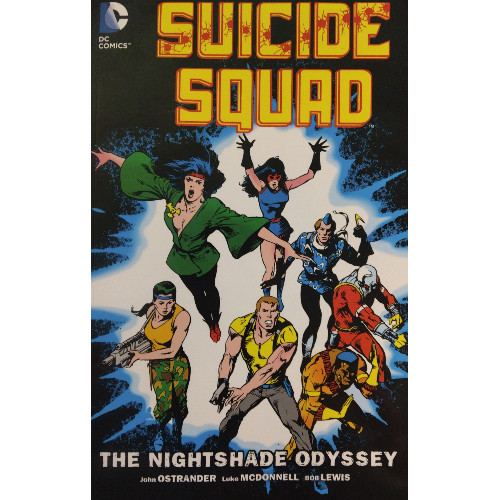
A while back, I explored the first handful of adventures by a motley crew of killers and criminals, thrown together to do the dirty jobs nobody else wanted in the hopes of getting some time knocked off their prison sentence. The catch? These folks could easily get knocked off themselves, either by their targets or other enemy forces…or, heck, even each other. And none of them should think about abandoning ship, because a little bomb strapped to their wrists will detonate in the event of taking unapproved vacation time. This crew is called the "Suicide Squad," cause going where they go and doing what they do is tantamount to a death sentence…a self-inflicted death sentence, I guess, cause they're the ones making the decision whether to take the plunge.
I more recently reviewed a collection of Justice League International issues that ended with JLI benefactor, shrewd businessman Maxwell Lord, in the hospital after being shot during DC's 1988 crossover event Millennium event by a Manhunter disguised as one of his employees. Tough place for Maxie to be, and in this volume, Amanda Waller, the Squad's handler, is going to make things harder for him.
That's the kind of person we're dealing with when it comes to Ms. Waller. She's tough, shrewd in her own right, and downright determined to not let anything stand in her way. Not Lord, not government officials, not even…Batman??? This is the world we enter in this second volume of Suicide Squad, where the political intrigue is just as heavy as a mission to liberate a small country from a dictator or put an end to a notorious drug dealer's operation. It's a messy, ugly world, far different from the more humorous environments the Justice League International run around. There's a "it's a dirty job, but someone's gotta do it" vibe to these half-heroes, except they don't really have to…which doesn't make the jobs any less dirty.
We'll have to see what they scrounge up in this second volume of their 1980s adventures…or maybe it's better to say we'll have to see who they put down.
Suicide Squad: The Nightshade Odyssey
Writers: John Ostrander, Keith Giffen, J.M. DeMatteis, Paul Kupperberg, and Robert Greenburger
Pencilers: Luke McDonnell, Keith Giffen, Erik Larsen, and Rob Liefeld
Inkers: Bob Lewis, Malcolm Jones III, Al Gordon
Colorists: Carl Gifford, Julianna Ferriter, Gene D'Angelo
Letterers: John Costanza, Todd Klein, Bob Lappan, Steve Haynie
Issues: Suicide Squad #9-16, Justice League International #13, Doom Patrol/Suicide Squad #1, and Secret Origins #28
Publication Dates: January 1988-August 1988
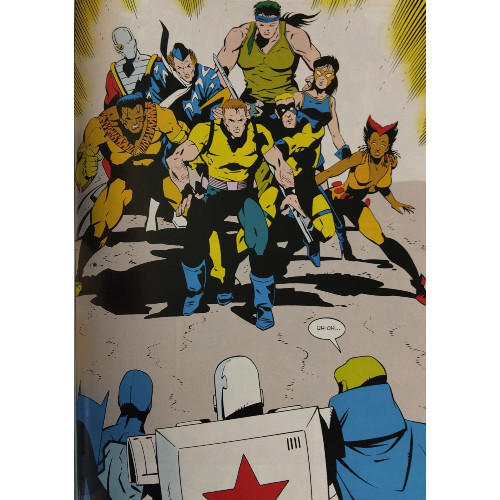
What I tend to enjoy about sequels, primarily books and movies (though video games and second seasons of TV series count as well), is they allow a certain sense of comfort when you open to the first page (or pop in the disk or start the first episode, whatever, you get it). In the first novel or film, a writer has introduced your primary characters and gotten you comfortable to who they are–their mannerisms, their strengths, their rough edges. A group dynamic is often established, meaning you enter the second narrative comfortably aware of the status quos for each character and between characters, even if they've been adjusted just a bit.
That's the feeling Ostrander (with help from a few other writers) and Luke McDonnell (with help from a few other artists) achieve in this volume. It's not an exact intention on their part, as they developed narratives on a monthly basis, not concerned with how those issues would eventually be packaged. But as the first issue of this volume opens, featuring a tie-in to Millennium, you find that comfort pretty quickly…and Ostrander and McDonell maintain that feeling throughout the volume.

You see it in the quick exchanges between characters–Captain Boomerang and Deadshot bickering while they battle Manhunters or Squad leader Rick Flag asserting whatever control he can over his morally compromised charges–knowing that, as these people work together, they're developing relationships. These guys and gals aren't friends, and they may not even trust each other completely, but they're finding out what works and what doesn't. Rick knows what he has to do to keep these people under control; Deadshot learns how to cope with Boomerang's snark; newer member Nightshade battles with the Enchantress to keep her under control and prevent her "wild card" transformations and antics from upending a mission to disrupt a major drug dealer's operations. The fun of the volume is watching these characters find friction between each other almost as much as they work together. Even superhero teams encounter confrontational personalities in their ranks, so imagine how often that happens when you're dealing with a team composed of supervillains, mercenaries, and murderers.
Ostrander and McDonell are also becoming more comfortable with individual characters, inserting fantastic moments to shape members. Flag, his life pockmarked with tragedy, deals with another loss in the volume's first issue, with the indication the event impacts him in at least one further issue. Boomerang gets a subplot where he impersonates Mirror Master, another member of Flash's rogues gallery, so he can sneak off and commit crimes without facing repercussions. New member Vixen, a former Justice Leaguer, joins the Squad, wrestling with her own animalistic tendencies after she murders a crime lord. My favorite moment in the volume centers on Nightshade and Speedy, Green Arrow's former sidekick who joins the Squad temporarily for one mission. During a conversation, the two share a brief look, wordlessly bonding over the darkness in their lives, which I interpret as a reference to Nightshade's childhood (which is elaborated on later) and Speedy's drug addiction. They don't harp on the specifics, just exchange a glance, but the moment is fraught with weight, guilt, and frustration. This is the kind of writing Ostrander excels at.
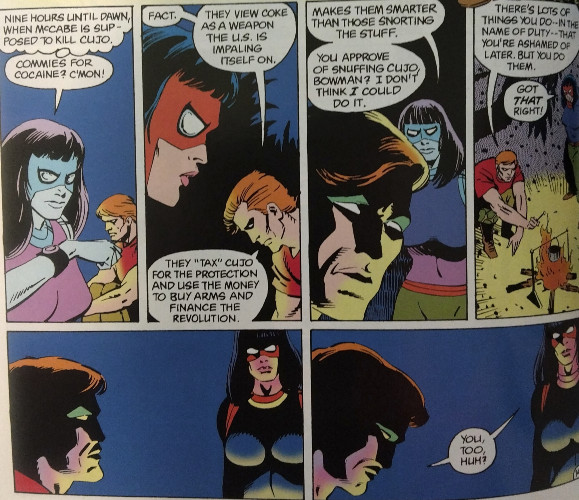
That comfort extends to the series' standout character, Amanda "The Wall" Waller. Ostrander invented her as someone who doesn't take "no" for an answer, as someone who deeply believes in a cause, and he showcases how formidable she is in a world where aliens, gods, and costumed superheroes run amok. Whether it's aggressively confronting Maxwell Lord, the then-hospitalized Justice League's spokesman, cutting through President Ronald Regan's political coyness to expose difficult truths, or threatening Batman himself (after taking a few potshots at him), Waller proves her nickname. The work she does is difficult, frustrating, and not without a generous helping of moral ambiguity. She has to be the person willing to cross certain lines while making sure others are cut in the concrete. It's a dangerous game she plays, convincing the current administration that those supervillains, mercenaries, and murderers are a necessity the world needs and can do the jobs the Justice League cannot, and Ostrander creates in her the fortitude necessary to dance between the lines.
It's a funny series to read this way, because you find yourself rooting for characters you normally wouldn't want to encourage or support. A two-part crossover with Justice League International allows an engaging dichotomy to play out between both teams, one issue more supportive of the JLI, the second issue more supportive of the Suicide Squad. Each working their own way to prevent an international incident, both teams come to blows, and you're asked to wrestle with who you want to come out on top…and it may not be the paragons of heroism and American justice, as you'd assume! When Vixen murders that crime leader, you engage with her feeling morally compromised, yet you also understand the importance–and, if someone like Waller can convince you, the need–of the mission. You're not walking along the same side of the tracks as Superman or Wonder Woman or any other goody-two shoes character when you're reading this collection. You're either on the other side of the tracks or on the tracks themselves, wondering if the Squad is allowed a balance between heroism and full-on vigilantism or if they'll never be given that option. Yeah, joining the Squad means knocking off some jail time…but it also means doing some things that would absolutely land you jail time if you were only working for yourself.
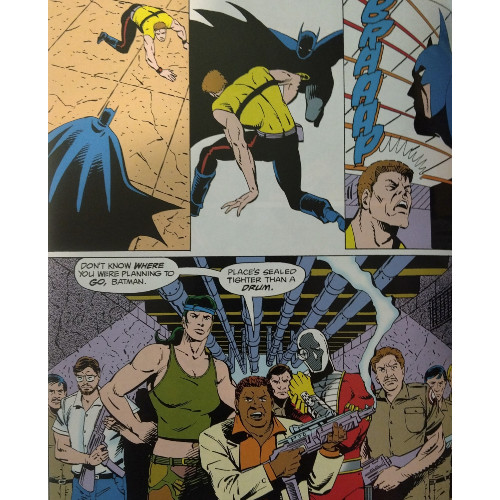
The body count, in terms of characters whose names we know, isn't terribly high, by my estimate. We get a noble sacrifice early in the volume, but most of the carnage comes from a Suicide Squad/Doom Patrol crossover special, plotted by Ostrander, written by Paul Kupperburg, and featuring pencils by Erik Larsen. Flag is paired with several different villains and sent on a mission to rescue Hawk of "Hawk and Dove" from a Nicaraguan prison, where the group collides with the Doom Patrol. As with the Justice League conflict, this debacle reeks of political manipulation, especially when Russian forces, including the Rocket Red Brigade, get involved. The whole issue feels like a blow against the Cold War, with these villains and soldiers (and Hawk himself) the victims of ongoing political feuds, especially when characters begin dying. Emotionally, I felt little connection to the fatalities, but the story itself plays out well otherwise, with plenty of action, a good helping of suspense, and a Pyrrhic victory which makes the mission all the more frustrating.
The volume ends on a bit of a slog for me, featuring a multi-part arc which gives this collection its title: "The Nightshade Odyssey." The story is fine, introduced by an origin for Nightshade illustrated by Larsen's Image Comics partner Rob Liefeld, but it weaves in otherworldly elements which feel out of place. The narrative relies on a generous dose of exposition and twists which feel poorly plotted, thrusting our characters into an over-the-top fantasy setting and employing dangers which don't feel as weighty when you know any of these guys could wind up on the receiving end of a bullet when fighting drug lords and Communist soldiers. It just doesn't carry the same quality as the rest of the collection, even if a surprise appearance by Steve Ditko's Shade the Changing Man is a welcome addition to the final issue.
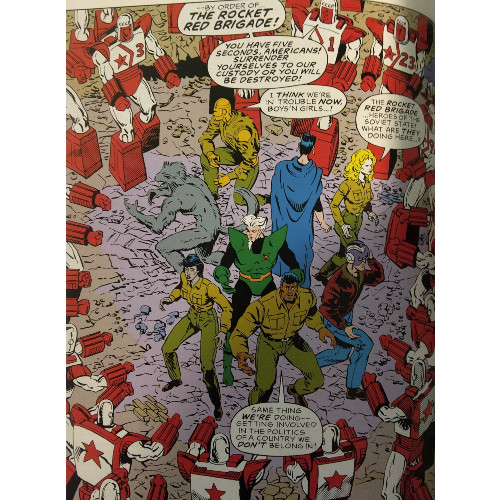
What we're given mostly, then, are strong stories which sell these characters as people you want to support and follow, even if you know you can't trust them and they can't trust each other. Moral ambiguity drives everyone, even Amanda Waller, adding to the intrigue of the series, especially when the Squad finds themselves pitted against characters traditionally seen as genuine heroes, like members of the Justice League. I do wish the final story was a little less wordy and entrenched in otherworldly lore, but aside from this, Ostrander capitalizes on characterization, with wonderful moments letting us see how these characters tick…and I don't just mean because they have bombs strapped to their wrists.